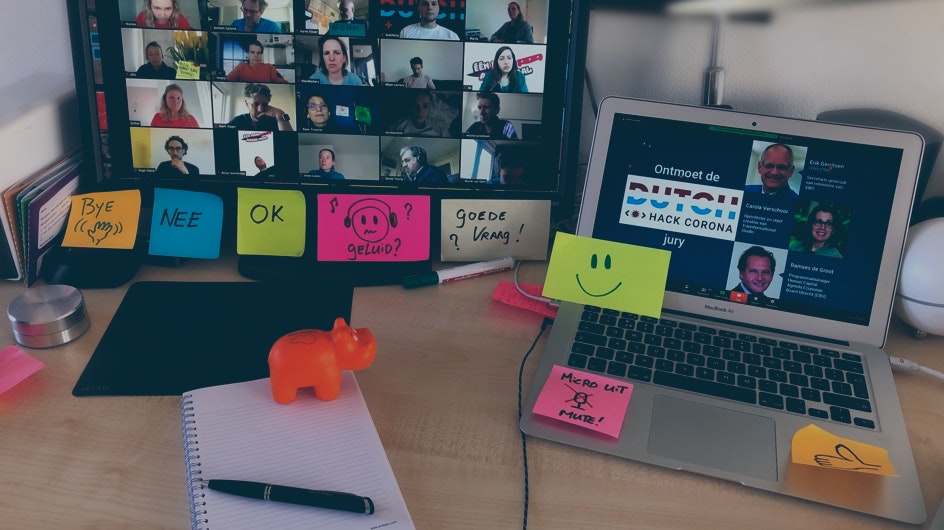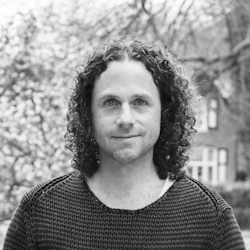Hack Corona
Author
William van der Moolen
Published
09 April 2020
Reading time
4 minutes
When the first Corona infection was detected in the Netherlands at the end of February 2020, many still thought it would blow over. A month later, our country looked very different. Empty stations, highways without traffic jams and many events that were cancelled. The sixth edition of Dutch Hacking Health too, threatened to be cancelled. A hackathon for patient-centered care. In a very short time, the organization transformed the event into an online hackathon (#hackcorona) with 600 people participating from their safe home location.
What makes hackathons so much fun (for designers)?
I have been an enthusiastic participant in hackathons for several years now. They are inspiring meetings where you meet people with different interests and expertise. You will work together with highly motivated strangers to come up with creative solutions for wicked problems in a very short time. Ideal testing grounds for devising solutions that people like to use, unimpeded by existing processes, techniques or agreements.
As designers, we often work in environments with many stakeholders in complex, hierarchical relationships. Challenging environments where it can sometimes be difficult to ‘sell’ a holistic approach to budget holders or product owners who have less experience with design thinking.
Hackathons are ideal for designers to develop ideas or visions about people-oriented design and test them in practice. And of course learning to pitch your idea and solution is an indispensable skill that will come in handy in your daily work.
What did we do?
Informaat supported Dutch Hacking Health with nine design coaches and organized the well-attended webinar Creative Thinking. The coaches guided 15 of the 68 participating teams in Design Thinking, collaboration and pitching to develop a promising concept for the final pitch on Demo Day.
**Step-by-step to success: From team canvas via problem definition to ideas **
One of the first tasks you take on with a team is to create a team canvas. Together you determine who is on your team, what motivation and expertise everyone brings along and what core values and rules you agree on. This makes it immediately clear which expertise is missing and how you make decisions with the team. Do you actually have users from the target group in your team? And what does that mean for developing and testing your idea? Co-creation with users provides faster and better insights than designing for users.

Analysis and problem definition
The second step is a good analysis of the problem the team wants to work on. You work out that analysis in a problem definition canvas. What is the real problem and who is most affected by it: the care recipient or the care provider?
This is the most important stage in the design process. It is crucial to arrive at a good concept within the limited time a hackathon offers. Teams that get started on an idea too quickly without thorough problem analysis often get stuck during the testing of their prototype and rarely manage to convince users and the jury in their pitch on Demo Day.

The brainstorm
The third step is the creative phase: brainstorming. As a coach, you have to quickly move the team from an evaluating/deciding mode back into the creative ‘anything goes’ mode. This can be done with different techniques. The Crazy-8 is an effective technique for collecting many different ideas in a short time. In eight minutes, each team member draws eight different ideas, one every minute. After those eight minutes, each team member briefly explains what he/she has come up with before the group chooses the best idea via dot-voting.

Then the moment comes when you as a coach sometimes have to cruelly tear the group apart. You let part of the group get to work on developing the idea, while another part of the team looks for suitable test users and scenarios for the prototype. And a few team members should start preparing for the pitch on Demo Day, a compelling two-minute presentation in which each team briefly explains why and for whom they came up with their solution, how it works practically and what the secret is that makes their solution successful.
And in all these steps the user remains central. Does the concept appeal to the user and, above all, will it actually tempt the user to start using it?
What have we learned?
Hackathons are always a source of inspiration for designers. Where else do you quickly come into contact with other fields, users and dilemmas? Where else do you learn so much about user behaviour, preferences and social context? It is always fantastic to experience how people get energy from your idea.
In my daily work, I often apply techniques such as Journey Mapping, Co-creation or Design Sprints in a physical setting with groups in a fixed space. In this edition of Dutch Hacking Health, I learned how well some of those techniques can survive in a 'digital-only setting' with tools such as MIRO, Trello and video calling. Even if not all participants have the same experience of collaborating on these types of digital platforms.
As Informaat coaches we look back with satisfaction on Dutch Hacking Health. Of the 68 teams that started the hackathon, two of the teams we supervised made it to the finals for the titles 'Best Human-Centered Design', 'Best Innovation' and 'Best Data-Driven Solution'. We are therefore quite proud that one of those teams received the audience award. But just as valuable is that a few of the teams we coached after the hackathon are still active in turning their concept into a successful product.
HackCorona was a great edition of Dutch Hacking Health. We would like to come back to the next edition, which is planned for this fall.
About the author

Public sector
Zorgdomein
eHealth



